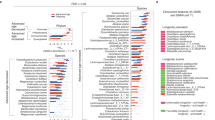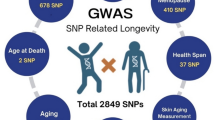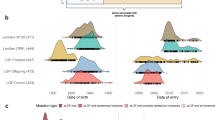Abstract
In this study, we introduce a centenarian-only approach to the assessment of gene-gene interaction that contributes to human longevity. This approach corresponds to the non-traditional case-only method in the genetic study of gene and disease associations. We first describe how the method can be implemented to screen for gene–gene interaction in human longevity. Then we apply the method to centenarian data collected from an Italian centenarian study in order to detect the interactions between the REN gene and the mitochondrial haplotypes. A significant interaction between REN gene allele 10 and the mitochondrial H haplotype, which may favour longevity, was found. Important features of the application in human longevity studies are highlighted and discussed. Since centenarians constitute a special population representing successful ageing, the centenarian-only approach will be an important tool in the search for major genes that contribute to human longevity.
Similar content being viewed by others
Log in or create a free account to read this content
Gain free access to this article, as well as selected content from this journal and more on nature.com
or
References
McGue M, Vaupel JW, Holm N, Harvald B . Longevity is moderately heritable in a sample of Danish twins born 1870–1880 J Gerontol 1993 48: B237–B244
Herskind AM, McGue M, Holm NV, Sorensen TI, Harvald B, Vaupel JW . The heritability of human longevity: a population-based study of 2872 Danish twin pairs born 1870–1900 Hum Genet 1996 97: 319–323
Yashin AI, Iachine IA . Genetic analysis of durations, Correlated frailty model applied to survival Danish Twins Genet Epidemiol 1995 12: 529–538
Wright, S. Evolution and the Genetics of Populations. Vol. 3: Experimental Results and Evolutionary Deductions Chicago: The University of Chicago Press 1977 pp. 474–497
De Benedictis G, Tan Q, Jeune B et al. Recent advances in human gene-longevity association studies Mech Ageing Dev 2001 1: 909–920
Schachter F, Faure-Delaneff L, Guenot F et al. Genetic associations with human longevity at the APOE and ACE loci Nat Genet 1994 6: 29–32
Kervinen K, Savolainen MJ, Salokannel J et al. Apolipoprotein E and B polymorphisms–longevity factors assessed in nonagenarians Atherosclerosis 1994 105: 89–95
Louhija J, Miettinen HE, Kontula K, Tikkanen MJ, Miettinen TA, Tilvis RS . Aging and genetic variation of plasma apolipoproteins. Relative loss of the apolipoprotein E4 phenotype in centenarians Arterioscler Thromb 1994 14: 1084–1089
Zhang JG, Ma YX, Wang CF et al. Apolipoprotein E and longevity among Han Chinese population Mech Ageing Dev 1998 104: 159–167
Gerdes LU, Jeune B, Ranberg KA, Nybo H, Vaupel JW . Estimation of apolipoprotein E genotype-specific relative mortality risks from the distribution of genotypes in centenarians and middle-aged men: apolipoprotein E gene is a “frailty gene,” not a “longevity gene” Genet Epidemiol 2000 19: 202–210
Piegorsch WW, Weinberg CR, Taylor JA . Non-hierarchical logistic models and case-only designs for assessing susceptibility in population-based case-control studies Stat Med 1994 13: 153–162
Khoury MJ, Flanders WD . Nontraditional epidemiologic approaches in the analysis of gene-environment interaction: case-control studies with no controls! Am J Epidemiol 1996 144: 207–213
Yang Q, Khoury MJ, Sun F, Flanders WD . Case-only design to measure gene-gene interaction Epidemiology 1999 10: 167–170
Fisher LD, Van Belle G . Biostatistics: A methodology for the health sciences N.Y.: John-Wiley & Sons 1993 pp. 191–200
De Benedictis G, Carotenuto L, Carrieri G et al. Gene/longevity association studies at four autosomal loci (REN, THO, PARP, SOD2) Eur J Hum Genet 1998 6: 534–541
Franceschi C, Motta L, Valensin S et al. Do men and women follow different trajectories to reach extreme longevity? Italian Multicenter Study on Centenarians (IMUSCE) Aging (Milano) 2000 12: 77–84
De Benedictis G, Rose G, Carrieri G et al. Mitochondrial DNA inherited variants are associated with successful aging and longevity in humans FASEB J 1999 13: 1532–1536
Yashin AI, De Benedictis G, Vaupel JW et al. Genes and longevity: Lessons from studies on centenarians J Gerontol 2000 55: B1–B10
Tan Q, De Benedictis G, Yashin AI et al. Measuring the genetic influence in modulating human life span: Gene-environment and gene-sex interactions Biogerontology 2001 2: 141–153
Peters J, Kranzlin B, Schaeffer S et al. Presence of renin within intramitochondrial dense bodies of the rat adrenal cortex Am J Physiol 1996 271: E439–E450
Clausmeyer S, Sturzebecher R, Peters J . An alternative transcript of the rat renin gene can result in a truncated prorenin that is transported into adrenal mitochondria Circ Res 1999 84: 337–344
Clausmeyer S, Reinecke A, Farrenkopf R, Unger T, Peters J . Tissue-specific expression of a rat renin transcript lacking the coding sequence for the prefragment and its stimulation by myocardial infarction Endocrinology 2000 141: 2963–2970
De Benedictis G, Carrieri G, Garasto S et al. Does a retrograde response in human aging and longevity exist? Exp Gerontol 2000 35: 795–801
Yang Q, Khoury MJ, Flanders WD . Sample size requirements in case-only designs to detect gene-environment interaction Am J Epidemiol 1997 146: 713–720
Kannisto V . Development of oldest-old mortality, 1950–1990: evidence from 28 developed countries Odense: Odense University Press; Odense 1994 pp. 51–54
Vaupel JW, Carey JR, Christensen K et al. Biodemographic trajectories of longevity Science 1998 280: 855–860
Khoury MJ . Genetic epidemiology in: Rothman KJ, Greenland S, (eds) Modern Epidemiology Philadelphia: Lippincott-Raven Publisher 1998 pp. 615–617
Acknowledgements
Qihua Tan appreciates his communication with Dr Susan Clausmeyer and Professor Joer Peters at the Department of Pharmacology, University of Heidelberg. We also want to thank Dr Karl Brehmer for help in preparing this study.
Author information
Authors and Affiliations
Corresponding author
Rights and permissions
About this article
Cite this article
Tan, Q., De Benedictis, G., Ukraintseva, S. et al. A centenarian-only approach for assessing gene–gene interaction in human longevity. Eur J Hum Genet 10, 119–124 (2002). https://doi.org/10.1038/sj.ejhg.5200770
Received:
Revised:
Accepted:
Published:
Issue date:
DOI: https://doi.org/10.1038/sj.ejhg.5200770
Keywords
This article is cited by
-
Puzzling role of genetic risk factors in human longevity: “risk alleles” as pro-longevity variants
Biogerontology (2016)
-
Polymorphisms in the superoxidase dismutase genes reveal no association with human longevity in Germans: a case–control association study
Biogerontology (2013)
-
Retrospective analysis of main and interaction effects in genetic association studies of human complex traits
BMC Genetics (2007)
-
The accuracy of statistical estimates in genetic studies of aging can be significantly improved
Biogerontology (2007)
-
Geneticists seek Queen Mum's secrets
Nature (2002)



